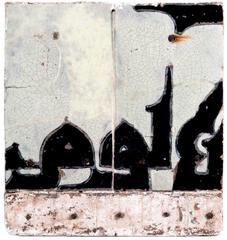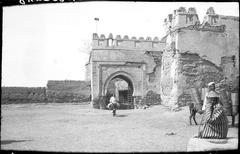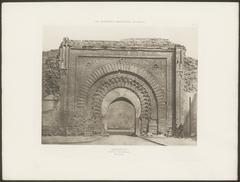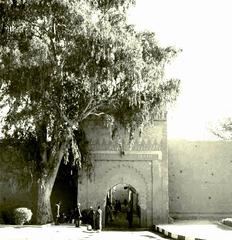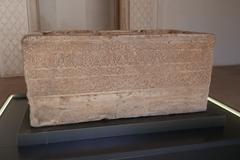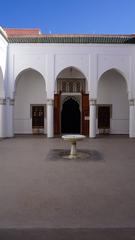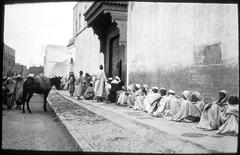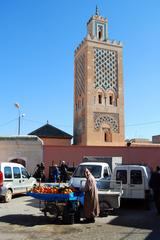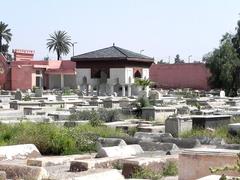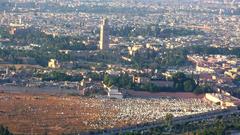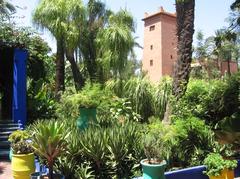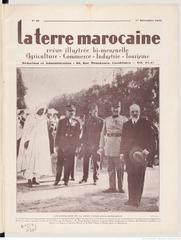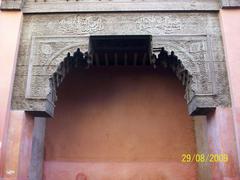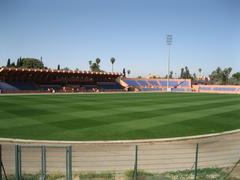La Mamounia Marrakesh: Visiting Hours, Tickets, and Historical Guide
Date: 14/06/2025
Introduction: La Mamounia’s History and Cultural Significance
Nestled in the heart of Marrakesh, La Mamounia is an enduring symbol of Moroccan luxury and heritage. More than a hotel, it is a historic estate whose origins trace back to the 18th century, when Sultan Sidi Mohammed Ben Abdellah gifted the legendary arsat gardens to his son, Prince Mamoun. This marked the beginning of a royal tradition and horticultural splendor that still defines the property today (Lampoon Magazine; Morocco Travel Blog). Since its establishment as a luxury hotel in 1929, La Mamounia has blended Moorish architectural grandeur with Art Deco elegance, showcasing intricate zellij tilework, cedar wood carvings, and sumptuous interiors that reflect centuries of Moroccan artistry (Parametric Architecture; Wikipedia).
Throughout its long history, La Mamounia has welcomed royalty, politicians, artists, and celebrities, and has played a crucial role in shaping Marrakesh’s cultural and social landscape (Foyer Magazine). Today, visitors can immerse themselves in this rich legacy while enjoying modern luxuries, diverse dining, and more than 20 acres of meticulously landscaped gardens (Morocco Travel Blog; La Mamounia Official Site). This comprehensive guide provides detailed insights into La Mamounia’s evolution, architectural highlights, cultural significance, and practical visitor information. Whether you are planning a day visit or an extended stay, this article equips you with all you need to experience the magic of one of Morocco’s most iconic landmarks (Condé Nast Traveler).
Table of Contents
- Royal Origins and Historical Evolution
- Architectural Synthesis: Moorish Grandeur Meets Art Deco
- Renovations and Contemporary Design
- Cultural Significance and Enduring Legacy
- Visitor Information: Hours, Tickets, Accessibility
- Preservation of Heritage and Local Artistry
- Architectural Highlights and Visitor Experience
- Celebrity Legacy
- Accommodation, Dining, and Facilities
- Nearby Attractions and Practical Tips
- FAQ
- Summary and Call to Action
- References
Royal Origins and Historical Evolution
La Mamounia’s origins are intertwined with Marrakesh’s royal history. In the 18th century, Sultan Sidi Mohammed Ben Abdellah gifted the arsat gardens to his son, Prince Mamoun, as a royal wedding present (Lampoon Magazine). These gardens became renowned for their beauty and as sites for family gatherings and cultural celebrations. The estate’s transformation into a hotel began in 1923, when French architects Henri Prost and Antoine Marchisio were commissioned to create a property that would attract international travelers while respecting Moroccan traditions (Wikipedia; Parametric Architecture). Opening its doors in 1929, La Mamounia quickly became a magnet for global dignitaries, celebrities, and royalty.
Major renovations across the 20th and 21st centuries, including those by Jacques Garcia in 2009 and Jouin Manku in 2020, have preserved its historic character while enhancing its luxury and comfort (Wikipedia; Interni Magazine).
Architectural Synthesis: Moorish Grandeur Meets Art Deco
La Mamounia’s architecture seamlessly blends Moroccan tradition with Art Deco sophistication. The original design incorporates horseshoe arches, zellij mosaics, carved cedar, and stucco inlays (Parametric Architecture). These are paired with the clean lines and geometric motifs of early 20th-century Art Deco, creating a unique, timeless aesthetic. The interiors highlight Moroccan craftsmanship, from hand-carved screens to tadelakt walls and opulent textiles in deep reds, greens, and gold (Marrakech in Morocco). Zellige tilework, crafted by local artisans, adorns fountains, courtyards, and corridors, while the gardens—spanning up to 20 acres—feature ancient olive groves, palms, and vibrant flowerbeds (Morocco Travel Blog).
Renovations and Contemporary Design
The 2009 restoration by Jacques Garcia introduced a richer color palette and theatrical luxury, with a focus on velvet, tassels, and close collaboration with Moroccan artisans (Wikipedia; Lampoon Magazine). In 2020, Jouin Manku’s redesign brought further innovation. The Centennial Chandelier—a centerpiece inspired by Tamazight jewelry—features over 500 pendants and sparkling glass beads, creating a dramatic welcome in the lobby (Interni Magazine). Renowned chefs Pierre Hermé and Jean-Georges Vongerichten redesigned the restaurants, and the hotel added a cinema and updated suites, all while honoring the original vision (Wikipedia).
Cultural Significance and Enduring Legacy
La Mamounia’s significance extends beyond architecture. It is a living symbol of Moroccan identity and hospitality, hosting historic events, summits, and a long roster of famous guests—including Winston Churchill, Charles de Gaulle, Franklin D. Roosevelt, Nelson Mandela, Yves Saint Laurent, and Paul McCartney (Wikipedia; Interni Magazine). The hotel has also featured in films such as Alfred Hitchcock’s “The Man Who Knew Too Much” and events like the Marrakech International Film Festival (Marrakech in Morocco). Its excellence is reflected in international accolades, including multiple Condé Nast Traveler awards (Mamounia.com).
Visitor Information: Hours, Tickets, Accessibility
- Visiting Hours: Public areas, including gardens and restaurants, are generally open to visitors from 10:00 AM to 6:00 PM. Some dining venues and spas may have extended hours.
- Tickets & Entry: No general admission fee for gardens or public spaces. Reservations are required for dining and spa experiences. Guided tours and special events may have ticket fees—check the official website or authorized operators.
- Accessibility: The hotel offers wheelchair access to most public areas and some rooms. Contact ahead for specific needs.
- Guided Tours: Available through local operators and the hotel concierge. These tours provide greater insight into La Mamounia’s history and architecture.
- Nearby Attractions: Jemaa el-Fnaa, Koutoubia Mosque, and Majorelle Garden are within easy reach.
- Special Events: The hotel hosts cultural events and festivals—consult the event calendar for public access.
Preservation of Heritage and Local Artistry
La Mamounia’s dedication to Moroccan heritage is evident in its use of local artisans for renovations and daily operations (Lampoon Magazine). Zellij tilework, stucco carving, and metalwork are passed down through generations, while the gardens reflect centuries-old traditions (Morocco Travel Blog). The use of local produce in restaurants and indigenous plants in the gardens underscores a commitment to sustainability and authenticity.
Architectural Highlights and Visitor Experience
The grand entrance, intricate mosaics, and iconic Centennial Chandelier immediately immerse guests in Moroccan artistry (Marrakech in Morocco). The hotel features 135 rooms, 71 suites, and three private riads, each adorned with artisanal detail and offering views of gardens or the Atlas Mountains (Wikipedia). The extensive gardens, fountains, and pools provide a tranquil oasis and are among the property’s most photographed features (Morocco Travel Blog).
Celebrity Legacy
La Mamounia’s legacy as a retreat for the world’s elite is legendary. Winston Churchill called it “the most enchanting place in the world,” and hosted political meetings and painted the city’s landscapes during his stays (Foyer Magazine). Other notable guests include Charles de Gaulle, Nelson Mandela, Ronald Reagan, and numerous Hollywood stars such as Brad Pitt, Angelina Jolie, Elton John, and Madonna (El País; Taylor Travelgram). The hotel is featured in films, fashion shoots, and media, and its commitment to discretion makes it a favored retreat for those seeking privacy (El País).
Accommodation, Dining, and Facilities
- Rooms and Suites: 209 rooms, including suites and signature riads, blend Moroccan tradition with modern luxury. Features include climate control, satellite TV, mini bar, and luxury bathrooms (La Mamounia Official Site).
- Wellness: Spa with Moroccan hammam, Turkish steam room, sauna, Jacuzzi, and a modern gym.
- Pools and Gardens: Indoor and outdoor pools surrounded by lush gardens, offering tranquil walking paths and shaded seating (La Mamounia Restaurants).
- Dining: Four restaurants—Le Marocain, L’Italien par Jean-Georges, L’Asiatique par Jean-Georges, and Le Pavillon de la Piscine—plus bars and tea rooms (La Mamounia Dining).
- Events and Business: Conference spaces and lounges for corporate or private events.
- Additional Services: Concierge, tours, airport transfers, 24-hour room service, valet parking, and multilingual staff.
Nearby Attractions and Practical Tips
- Nearby Sites: Jemaa el-Fnaa, Koutoubia Mosque, Bahia Palace, Saadian Tombs, and the souks are all within walking distance.
- Travel Tips: Book dining and spa appointments in advance; wear comfortable shoes for exploring the medina; respect dress codes in public areas.
- Accessibility: The hotel offers ramps and elevators, though some historic features may present challenges—contact the hotel for specific needs (Condé Nast Traveler).
- Getting There: About 15 minutes by taxi from Marrakesh Menara Airport.
FAQ
Q: What are La Mamounia’s visiting hours?
A: Public spaces are open from 10:00 AM to 6:00 PM, with some dining and spa facilities open later.
Q: Is there an entry fee?
A: No general admission fee. Reservations are required for dining, spa, and guided tours.
Q: Are non-guests welcome?
A: Yes, with reservations for dining or spa services. Some areas are exclusive to hotel guests.
Q: Is the hotel family-friendly?
A: Yes, children are welcome with adults.
Q: Are guided tours available?
A: Yes, via the concierge or local operators.
Q: Is La Mamounia accessible?
A: Most public areas are wheelchair accessible; contact ahead for specific needs.
Q: What are the best nearby historical sites?
A: Jemaa el-Fnaa, Koutoubia Mosque, Bahia Palace, and Saadian Tombs.
Q: How far is the hotel from the airport?
A: Approximately 15 minutes by car.
Summary and Call to Action
La Mamounia is a quintessential representation of Morocco’s rich cultural tapestry, intertwining royal heritage, architectural mastery, and modern luxury. From its royal orchard origins to its status as a globally renowned hotel, La Mamounia offers visitors an immersive journey through Moroccan artistry and hospitality (Wikipedia; Parametric Architecture). Its gardens, dining, and proximity to Marrakesh’s historical sites make it a perfect base for exploring the city (Morocco Travel Blog; Condé Nast Traveler). Book your visit in advance, respect local customs, and enjoy one of the world’s most elegant hotels.
For travel tips, updates, and exclusive offers, download the Audiala app and follow us on social media.
References
- Lampoon Magazine
- Morocco Travel Blog
- Wikipedia
- Parametric Architecture
- Foyer Magazine
- Wanderlust Chloe
- El País
- Interni Magazine
- Taylor Travelgram
- Marrakech in Morocco
- La Mamounia Official Site
- Condé Nast Traveler
- Accidentally Wes Anderson
- Stoked to Travel
